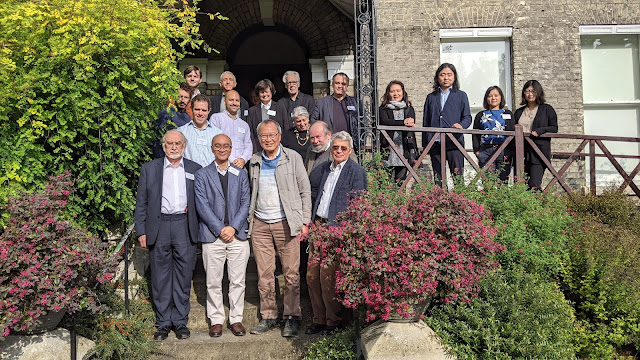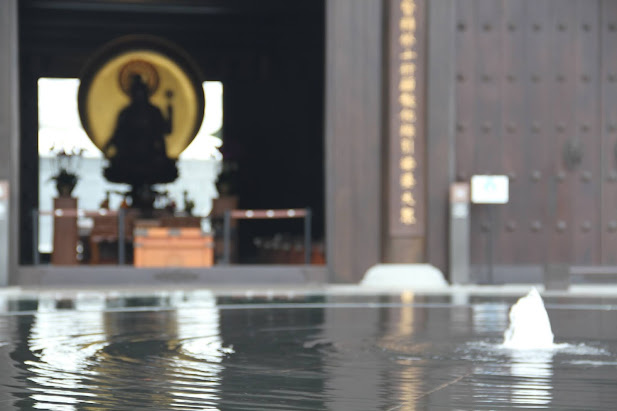A commonality between ancient and modern libraries is their capacity to house collections of books (Sometimes as thematic libraries, like the
Law Library of the Congress, in the U.S.A., or as general libraries, like the
Hong Kong Central Library) that are functional, and provide a space for readers to wade through their pages; in the case of
Tsz Shan Monastery, our faithfulness to tradition and scholarship, together with the sustained presence of volunteers and visitors, makes it so that we do not only house numerous volumes of the
Tripiṭaka (三藏/त्रिपिटक), but also that we can provide a place for such volumes, and many other books on Buddhist content to be read and studied properly.
Thanks the sustained support of our many volunteers, our collection has grown from few specific compilations of very traditional sutras to several thousand DVDs, magazines, encyclopedias and books on many different subjects, covering a wide range of themes, styles and languages, all around the subject of Buddhism. With the increase of our bibliographical collection, however, also came an increase in the elements to consider when maintaining our collection in good shape. Thanks to Dr. Bill Mak, our Principal Researcher, a project was put in motion with the objective of establishing a comprehensive, efficient and useful library for visiting researchers, while also providing a reading space for anyone interested in learning about general aspects of Buddhism, all the while keeping precious volumes of Buddhist sutras properly safeguarded.
(Chinese section of the Tsz Shan Monastery Buddhist Art Museum Research Library)
Having used the
library of my
university many times before, I was acquainted with some details of its classification system: Indeed, if one means to house a sizable collection of literary references, there are some international standards that can be applicable to any library, no matter the size. So when my colleagues and I were told about the necessity to revamp our library system, and about the idea of separating our collection by the type of reader that would enjoy each section of the collection, I was excited about the chance to get more closely acquainted with the Buddhist volumes at our disposal.
One of the most important steps when organizing a library is, without a doubt, making sure that the books are in good shape. For this purpose, and inspired by Buddhist tradition, we organized a
sun drying (晒经节) activity with our volunteers. After receiving a lecture on the history and importance of sutra copying and drying, our volunteers helped us with three main tasks: Relocating books, sun drying and shelf cleaning.
The starting point of the activity was our Tripitaka Library (藏經閣). In there, the monastery houses some very significant collections from each of the three baskets (Discourses, rules and philosophy), and the volunteers and staff were tasked with opening the books under the sunlight (To diminish any humidity contained inside of the books), cleaning any dust that could be on the books, and arranging the new additions to the collection that would belong to this hall. Due to the contents and the religious importance of the objects, most of our volunteers took to this task, which required attentive care and mindful handling of the volumes. The end result was a tasteful, well ordered distribution, which goes well with the parallel use of this hall as meditation room for our monastic community.
(Present state of the Tripitaka Library)
Next was the relocation of the volumes that would be housed in the Museum library. Being the newest collection, and soon to be of use for the upcoming research programs that will complement the development of our Museum's efforts on spreading awareness and appreciation for the rich artistic value of Buddhist art, many of the books that were originally located in the Learning Commons, and even some of the ones located in the Tripitaka Hall were transported to their new location. As many of these collection had numerous volumes (One collection of medicine sutras, for example, had 100 volumes of more than 600 pages each!), our volunteers traveled several times back and forth between venues with carts full of books, while keeping track of the intended destination for each one of them.
In this regard, however, the most challenging venue to reorganize was the Learning Commons.
The Learning Commons, which is a venue that sees extensive use by many of our volunteers and staff, houses our Buddhist books that do not belong to a specific set of sutras; instead, this collection includes many different topics and authors: From vegetarian cuisine to language learning, this collection is very varied both in content and in format, and keeping track of the location and condition of each item can be challenging at times. The answer to this test was to take stock of all the books contained in the monastery, label them, and to take note of their condition after a simple routine of maintenance, which consisted in dusting (Plus sun-drying and airing in the case of books) and relocating them in their original position. The result was a neat and symmetrical library full of interesting and enriching Buddhist content.
As the summer weather was perfect for this sun-drying exercise, everyone worked very hard to make sure that the books were taken care of in the best possible way, and it was a happy occasion to share in the care and passion that the volunteers demonstrated when being in close contact with Buddhist texts. As many times in the past history of the monastery, and as it has always been in the history of Buddhism itself, the monastic community and Buddhist institutions can grow and thrive thanks to the invaluable effort of those who selflessly and sincerely believe in Dharma: Thanks to them, and to the efforts of the many people who uphold the Teachings, sentient beings get ever closer to the ceasing of their suffering.













































